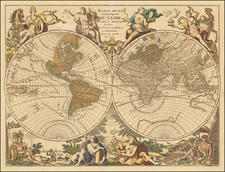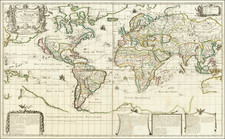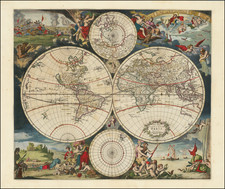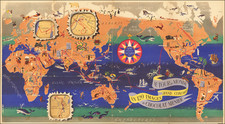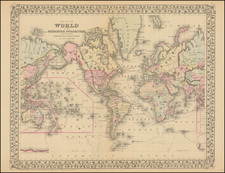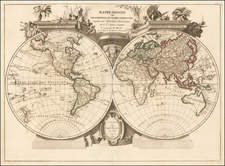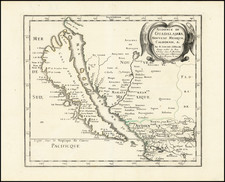Hubert Jaillot's World Map Re-Issued At the End of the 18th Century
Scarce Dutch decorative double hemisphere map of the World one of the most unique and decorative world maps of the period.
By the end of the 17th Century, Paris was supplanting Amsterdam as a map publishing center and the tradition of highly decorative Dutch engraved maps was being replaced by the more scientific and utilitarian map first produced by Nicolas Sanson in the mid 17th Century. Jaillot's map was one of the last thematically unique world maps, retaining much of the decorative style of earlier Dutch world maps, but trending toward cleaner and simpler imagery in the embellishments.
Eight large and allegorical figures surround the two hemispheres. In the four corners are figures representing the continents: Europe shown as a Queen surrounded by symbols of power and learning; America as an Indian surrounded by a monkey and parrots, with many ships shown off the horizon; Asia holding an incense burner sitting next to a camel, and Africa as a African maid sitting under an umbrella by a pyramid and surrounded by and crocodile, lion and elephant. In the center, two at top and two at the bottom, are four virtues.
Cartographically, the map shows many of the contemporary cartographic myths, including California as an island, a large unknown southern continent and massive Terra Iesso, extending from Northeast coast of Asia to the Northwest Coast of America, separated by a small unnamed strait. The incomplete Australian and New Zealand Coastlines are shown, along with a partial understanding of Tasmania (Van Diemen's Land) and the Northeastern parts of Australia.
First issued by Hubert Jaillot in the 17th Century, the map world endure for nearly 100 years, with Ottens and Elwe issuing later editions of the map.
The popular misconception of California as an island can be found on European maps from the sixteenth through the eighteenth centuries. From its first portrayal on a printed map by Diego Gutiérrez, in 1562, California was shown as part of North America by mapmakers, including Gerardus Mercator and Abraham Ortelius. In the 1620s, however, it began to appear as an island in several sources. While most of these show the equivalent of the modern state of California separated from the continent, others, like a manuscript chart by Joao Teixeira Albernaz I (ca. 1632) now in the collection of the National Library of Brasil shows the entire western half of North Americas as an island.
The myth of California as an island was most likely the result of the travel account of Sebastian Vizcaino, who had been sent north up the shore of California in 1602. A Carmelite friar, Fray Antonio de la Ascensión, accompanied him. Ascension described the land as an island and around 1620 sketched maps to that effect. Normally, this information would have been reviewed and locked in the Spanish repository, the Casa de la Contratación. However, the manuscript maps were intercepted in the Atlantic by the Dutch, who took them to Amsterdam where they began to circulate. Ascensión also published descriptions of the insular geography in Juan Torquemada’s Monarquia Indiana (1613) (with the island details curtailed somewhat) and in his own Relación breve of ca. 1620.
The first known maps to show California as an island were on the title pages of Antonio de Herrera’s Descripción de las Indias Occidentales (1622) and Jacob le Maire's Spieghel Der Australische Navigatie (1622). Two early examples of larger maps are those by Abraham Goos (1624) and another by Henry Briggs, which was included in Samuel Purchas’ Hakluytus Posthumus or Purchas his Pilgrimes (1625). In addition to Briggs and Goos, prominent practitioners like Jan Jansson and Nicolas Sanson adopted the new island and the practice became commonplace. John Speed’s map (1626-7), based on Briggs’ work, is well known for being one of the first to depict an insular California.
The island of California became a fixture on mid- and late-seventeenth century maps. The island suggested possible links to the Northwest Passage, with rivers in the North American interior supposedly connecting to the sea between California and the mainland. Furthermore, Francis Drake had landed in northern California on his circumnavigation (1577-80) and an insular California suggested that Spanish power in the area could be questioned.
Not everyone was convinced, however. Father Eusebio Kino, after extensive travels in what is now California, Arizona, and northern Mexico concluded that the island was actually a peninsula and published a map refuting the claim (Paris, 1705). Another skeptic was Guillaume De L’Isle. In 1700, De L’Isle discussed “whether California is an Island or a part of the continent” with J. D. Cassini; the letter was published in 1715. After reviewing all the literature available to him in Paris, De L’Isle concluded that the evidence supporting an insular California was not trustworthy. He also cited more recent explorations by the Jesuits (including Kino) that disproved the island theory. Later, in his map of 1722 (Carte d’Amerique dressee pour l’usage du Roy), De L’Isle would abandon the island theory entirely.
Despite Kino’s and De L’Isle’s work, California as an island remained common on maps until the mid-eighteenth century. De L’Isle’s son-in-law, Philippe Buache, for example, remained an adherent of the island depiction for some time. Another believer was Herman Moll, who reported that California was unequivocally an island, for he had had sailors in his offices that claimed to have circumnavigated it. In the face of such skepticism, the King of Spain, Ferdinand VII, had to issue a decree in 1747 proclaiming California to be a peninsula connected to North America; the geographic chimera, no matter how appealing, was not to be suffered any longer, although a few final maps were printed with the lingering island.

